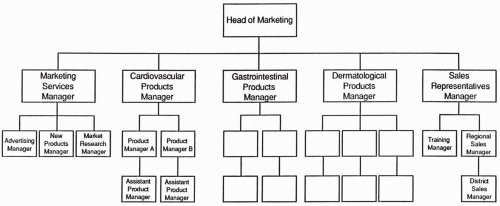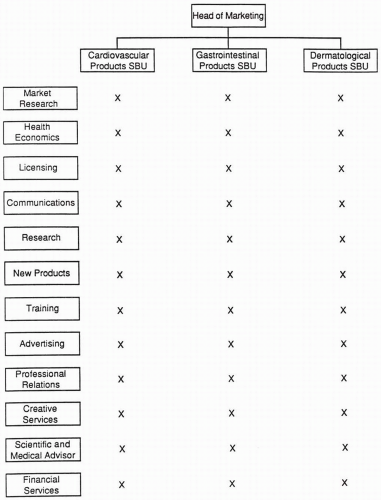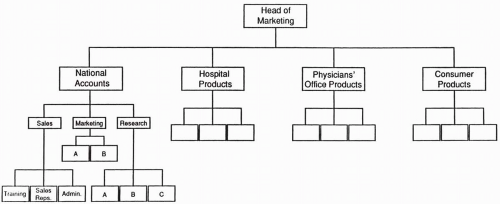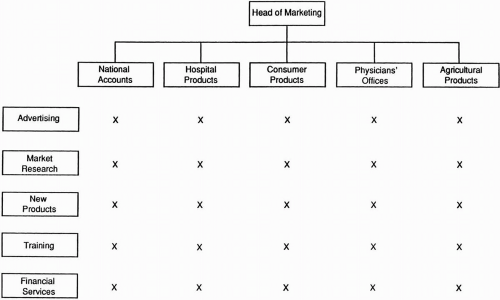Organizational and Staffing Issues Regarding the Medical-Marketing Interface
Pareto’s Law (the 20/80 rule) =
20% of events yield 80% of results
20% of your customers produce 80% of sales
20% of donors contribute 80% of gifts
20% of your inventory produces 80% of volume
HOW ARE MARKETING GROUPS ORGANIZED?
Within a pharmaceutical company, a marketing group is usually organized into either a discipline-oriented traditional line function system or a matrix function system. The latter consists of strategic business units, each of which acts as an independent entity containing groups and individuals to conduct all necessary activities.
Line Function System
Most line function systems keep the staffs in marketing service groups (e.g., advertising, research, health economics, new product development) together so that they may jointly or individually provide help to the major marketing groups (Fig. 94.1). A significant advantage of the line function approach, which keeps professionals in similar disciplines together, is the expected achievement of greater esprit de corps and greater synergy in ideas and performance. A critical mass is sought in most marketing areas to market drugs efficiently.
Matrix Function System: Strategic Business Units
The approach to organizing the matrix system in marketing is similar to that used for organizing the project system in research and development (R and D; see Chapter 48). This means that staff from various service groups (e.g., market research or advertising) usually are divided among the major marketing groups to create interdisciplinary “business” units (Figs. 94.2 and 94.3), although sometimes they are not (Fig. 94.4). Each of these business units
may act independently with its own general manager and even with its own dedicated sales staff. Business units may be established for (a) over-the-counter drugs, (b) large retail and wholesale accounts, (c) hospitals, or (d) prescription drugs; or business units may be established for individual therapeutic areas if the company is large enough and has a critical number of products in two or more therapeutic areas. Marketing services (partly shown in the figures) are more completely listed in Table 94.1.
may act independently with its own general manager and even with its own dedicated sales staff. Business units may be established for (a) over-the-counter drugs, (b) large retail and wholesale accounts, (c) hospitals, or (d) prescription drugs; or business units may be established for individual therapeutic areas if the company is large enough and has a critical number of products in two or more therapeutic areas. Marketing services (partly shown in the figures) are more completely listed in Table 94.1.
 Figure 94.1 Organizational chart for the marketing function based on line management structure and focusing on therapeutic area products. |
Two specific problems that can arise in strategic business units are briefly mentioned. First, many of the company’s products are sold by two or more of the strategic business units. This usually means that each has its own forecast to meet. It is difficult to track sales achieved for a particular drug for each strategic business unit, unless an approximate percentage of sales can be easily determined. If two or more units are competing for sales that could be achieved in a hospital versus a national account or in physicians’ offices, counterproductive competition within the company may occur.
Second, if there is no single person identified as the overall product or “brand” manager within the company for each product, then some type of unity of purpose is required to carry out the strategy associated with the brand. This may be achieved by having periodic meetings of all relevant personnel to review the product’s status, the success of its current strategy, and plans to chart the product’s future course. Without this type of meeting or other communication to yoke together various groups, it is possible, and even likely, that at least some groups will move in different directions or will assign the product’s activities a different priority than that given by other senior marketing managers.
A chart that illustrates the line function of global marketing heads in a large organization and dotted line relationships with global heads of clinical product development is shown in Fig. 94.5, and another chart that illustrates dotted line relationships between the global marketing head of a product and two different types of medical groups that each are responsible for different aspects of the same drug is shown in Fig. 94.6.
Physical Locations of Marketing and Medical Groups
The issue of where medical and marketing groups should be located in relation to one another rarely arises as a major consideration in pharmaceutical companies. Medical and marketing groups may be placed in separate areas of the same building, separate buildings on the same site, separate locations within the same city, or separate cities. Nonetheless, if the concept of a team approach to drug development is truly considered important, it makes sense to consider placing at least some medical and marketing representatives in relatively close proximity or even in the same building. Some companies have placed all members of a therapeutic area team (e.g., rheumatology, cardiovascular) together. These individuals work to develop all drugs in that therapeutic area. Drugs are each established as separate projects, just as with other organizational approaches. To create the best environment for this approach to be successful, it makes most sense for the medical personnel to be responsible for carrying out all phases of clinical development (i.e., Phases 1 to 4). If one medical group handles only one or two phases of development and a separate medical group handles the others, it creates greater potential for problems to arise in terms of interactions with marketing professionals.
The approach of physically integrating medical and marketing personnel sacrifices some of the benefits that marketing (and medical) professionals gain by being in close proximity and interacting frequently with their colleagues in related medical or marketing fields. Trade-offs must be considered when deciding whether greatest efficiencies and benefits are achieved through a closer working relationship and physical proximity of medical and marketing groups or through interactions within their own area. If the company is not too large, then other disciplines may also be closely brought together with marketing and medical staffs, such as various research (e.g., pharmacology, chemistry, and biochemistry) and development (e.g., metabolism, chemical scaleup, analytical development, and formulation) groups. This
would involve consideration of how much laboratory space would be required to achieve this goal, even if the staffs were not too large.
would involve consideration of how much laboratory space would be required to achieve this goal, even if the staffs were not too large.
 Figure 94.2 Organizational chart for the marketing function based on a matrix management structure of separate business units (SBUs). |
HOW ARE MEDICAL GROUPS ORGANIZED?
In Chapter 41, a discussion comparable to the one previously mentioned for marketing is given, and schematics are shown and described in more detail.
WHERE SHOULD VARIOUS GROUPS AND FUNCTIONS BE PLACED WITHIN THE COMPANY’S ORGANIZATION?
Licensing, Pharmacoeconomics, Health Policy, and Quality-of-life Activities
Every company’s situation is unique and must be assessed independently without application of rigid rules. Each of the groups in the subheading above could be organizationally placed in several different disciplines of the same company. Moreover, the optimal organization could change over the years depending on
pressures on the company, the nature of the investigational or marketed drug portfolio, or the personalities and strengths of the senior managers. This section describes those factors that should be evaluated in determining where to place a specific function. A suggestion is then made about the most commonly acceptable group (discipline) in which to place each of the four functions listed in this section’s heading.
pressures on the company, the nature of the investigational or marketed drug portfolio, or the personalities and strengths of the senior managers. This section describes those factors that should be evaluated in determining where to place a specific function. A suggestion is then made about the most commonly acceptable group (discipline) in which to place each of the four functions listed in this section’s heading.
Table 94.1 Marketing services that are often provided within a marketing division a | ||||||||||||||||||||||||||||||||||
|---|---|---|---|---|---|---|---|---|---|---|---|---|---|---|---|---|---|---|---|---|---|---|---|---|---|---|---|---|---|---|---|---|---|---|
| ||||||||||||||||||||||||||||||||||
Stay updated, free articles. Join our Telegram channel

Full access? Get Clinical Tree




